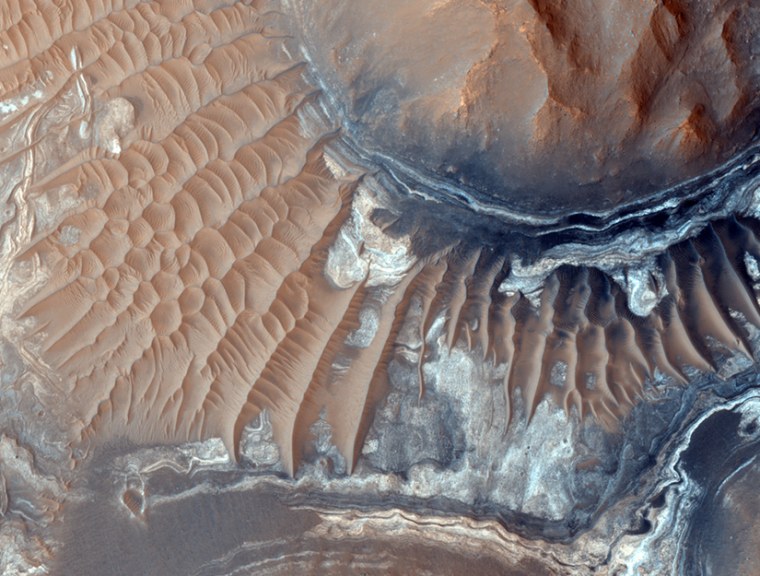Scientists have found water-bearing deposits on Mars that are out of step with what was happening elsewhere on the planet, raising the prospect that the sites could have played host to Martian life's last stand.
The deposits are a type of clay called smectites, which contain a blend of silica with aluminum, iron or magnesium. They form in the presence of water.
The deposits were found in an unlikely locale — roughly 30 feet up from the ground inside two troughs in Noctis Labyrinthus ("the labyrinth of the night"), a maze-like system of deep valleys located near the western end of the massive Valles Marineris canyon that cuts across the face of Mars.
Other smectites have been found on Mars, but only in areas with rock dating back to an older period in the planet's history, known as the Noachian age, which spans from about 3.6 billion to 4.5 billion years ago.
The planet's climate is then believed to have shifted, leading to a new geologic epoch marked by minerals that formed under more acidic conditions.
"So far, we've found these kinds of clays in the very oldest terrain," lead research Catherine Weitz, with the Planetary Science Institute, told Discovery News. "In our study, we see these same kind of smectites, but they formed in these depressions, these troughs, that are probably much younger."
The Noctis Labyrinthus smectites are believed to have formed around 2 billion to 3 billion years ago, possibly providing a haven for life when the rest of the planet dried out.
"It was a surprise to see such young clays that must have formed in a persistent water under neutral conditions," Weitz said. "If there's life on Mars, if it had persisted, this would be a nice place for it, because it does indicate that there was water in this location on the surface at that relatively young age."
Chemical analysis collected from probes orbiting Mars shows the troughs in Noctis Labyrinthus filled with minerals in reverse order to what was happening across the planet globally.
"The hard part is how do you get water up that high and how do you get it at that time," planetary geologist Matt Golombek told Discovery News.
Clays, in general, are ideal for preserving organics, if any exist, because the material can seal things off from water that comes later.
"Clay-rich materials are extremely good at preserving evidence for life," said Golombek. "That's part of what makes going to them such a compelling story."
Scientists are about to get their first close-up studies of Martian clays. The long-lived rover Opportunity recently arrived at the rim of a 14-mile wide crater called Endeavour that contains hydrated clays.
And the Cadillac of rovers is not far behind. NASA's Mars Science Laboratory, nicknamed Curiosity, is to due to launch Nov. 25 to explore the clay-rich deposits in Gale Crater.
The Noctis Labyrinthus deposits are off-limits to rovers — the terrain is too high and too steep to be accessible — but scientists are hopeful the studies in Endurance and Gale craters will fill in missing pieces of the Mars story.
Weitz's research appears in this week's Geology.
